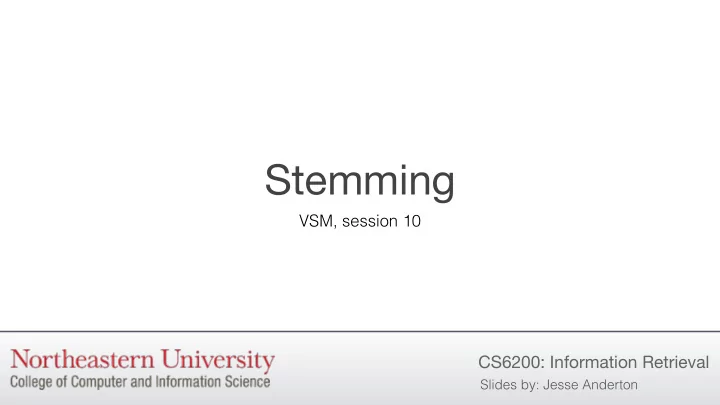

Stemming VSM, session 10 CS6200: Information Retrieval Slides by: Jesse Anderton
Stemming A stemming algorithm converts words to k i t a b a book their root forms (“stems”) in order to focus k i t a b i my book on their underlying meaning. al k i t a b the book ‣ It works well in English or in Arabic, k i t a b uki your book (f) with many nouns and verbs deriving from a common root k i t a b uka your book (m) k i t a b uhu his book ‣ It works worse in German or Turkish, which compose very long words with k a t a b a to write complex meanings. ma kt a b a library, bookstore It’s common to add the root to the query’s ma kt a b office term vector (while leaving the unstemmed Arabic words that stem to ktb form present).
çekoslovakyalila ş tiramadiklarimizdanmi ş siniz “(it is speculated that) you had been one of those whom we could not convert to a Czechoslovakian.” –Common example of a Turkish word demonstrating agglutinative languages.
Stemming Algorithms Two major families of stemming algorithms exist: ‣ Dictionary-based stemmers use lists of related words. ‣ Algorithmic stemmers use some algorithm to derive related words. A simple algorithmic stemmer for English may remove the suffix -s: ‣ cats → cat, lakes → lake, plays → play ‣ But many false negatives: supplies → supplie ‣ And some false positives: ups → up Producing high quality rules is very challenging.
Porter Stemmer The Porter Stemmer was developed in the 70’s, and consists of a large series of rules to repeatedly apply until only the stem is left. It is fairly effective, though makes many categorical errors. Its complexity makes it hard to modify, though the porter2 stemmer fixes some of its problems. It outputs stems, not recognizable Porter Stemmer, step 1 of 5 words.
Krovetz Stemmer The Krovetz Stemmer is a hybrid of dictionary and algorithmic methods. It first checks the dictionary. If not found, it tries to remove suffixes and then checks the dictionary again. It produces recognizable words, unlike the Porter stemmer. Its effectiveness is comparable to the Porter stemmer. It has a lower false positive rate, but somewhat higher false negative.
Stemmer Comparison
Stem Classes A given stemming algorithm creates stem classes of words which are stemmed to the same root. These classes are generally too large and varied in meaning to use for query expansion, but they can be narrowed down using term co-occurrence statistics. The assumption is that those terms which tend to appear in the same Stem classes, before and after term co- document are more likely to be related occurrence thinning is applied (or interchangeable).
Wrapping Up Adding words from query terms’ stem class is an effective way to improve document matching. Many stemming algorithms exist; the Porter and Krovetz are commonly used, but there are many other popular stemmers (e.g. the Snowball stemmer, with variants for many languages). Next, we’ll discuss term co-occurrence statistics, which can be used to fix stem classes and identify other related words to add to the query vector.
Recommend
More recommend